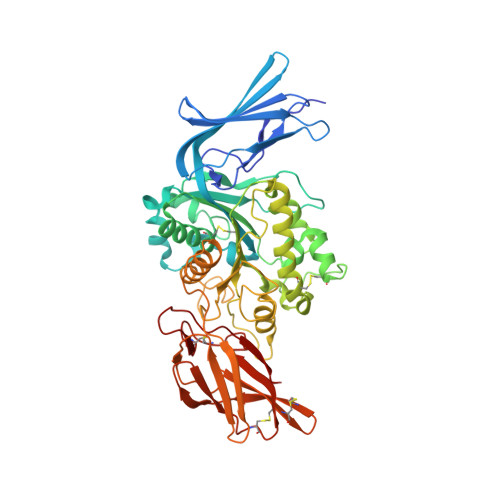Structural Analysis of Mammalian Sialic Acid Esterase.
Ide, D., Gorelik, A., Illes, K., Nagar, B.(2024) J Mol Biology 436: 168801-168801
- PubMed: 39321866
- DOI: https://doi.org/10.1016/j.jmb.2024.168801
- Primary Citation of Related Structures:
8F9O, 8F9P, 8F9Q, 8F9R - PubMed Abstract:
Sialic acid esterase (SIAE) catalyzes the removal of O-acetyl groups from sialic acids found on cell surface glycoproteins to regulate cellular processes such as B cell receptor signalling and apoptosis. Loss-of-function mutations in SIAE are associated with several common autoimmune diseases including Crohn's, ulcerative colitis, and arthritis. To gain a better understanding of the function and regulation of this protein, we determined crystal structures of SIAE from three mammalian homologs, including an acetate bound structure. The structures reveal that the catalytic domain adopts the fold of the SGNH hydrolase superfamily. The active site is composed of a catalytic dyad, as opposed to the previously reported catalytic triad. Attempts to determine a substrate-bound structure yielded only the hydrolyzed product acetate in the active site. Rigid docking of complete substrates followed by molecular dynamics simulations revealed that the active site does not form specific interactions with substrates, rather it appears to be broadly specific to accept sialoglycans with diverse modifications. Based on the acetate bound structure, a catalytic mechanism is proposed. Structural mapping of disease mutations reveals that most are located on the surface of the enzyme and would only cause minor disruptions to the protein fold, suggesting that these mutations likely affect binding to other factors. These results improve our understanding of SIAE biology and may aid in the development of therapies for autoimmune diseases and cancer.
- Department of Biochemistry and Centre de Recherche en Biologie Structurale (CRBS), McGill University, Montreal, QC H3G 0B1, Canada.
Organizational Affiliation:





















